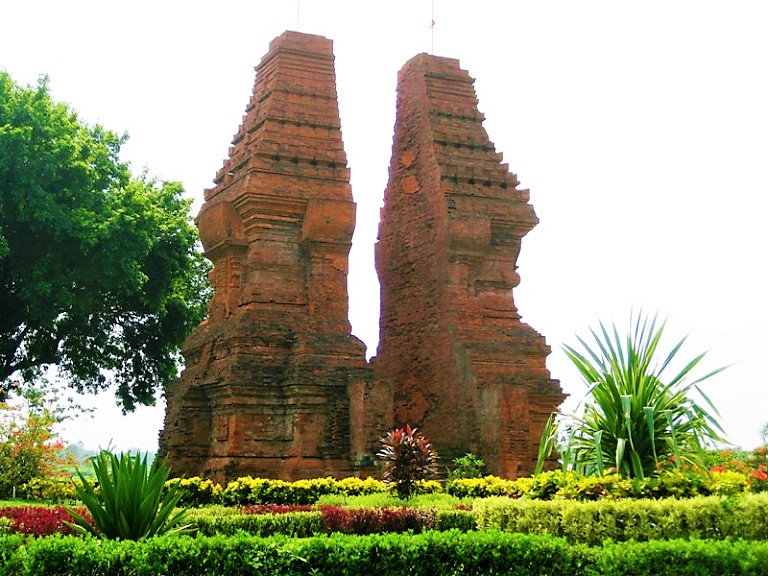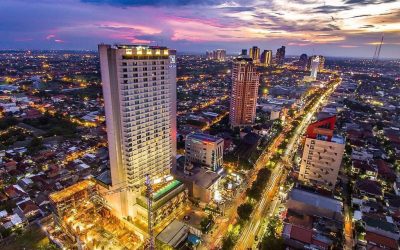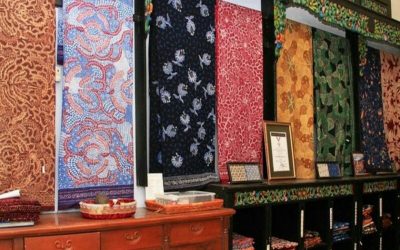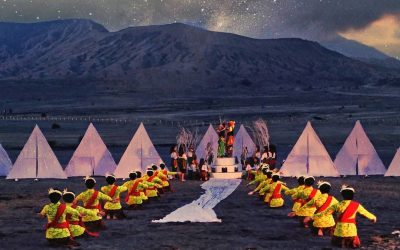Home / Batik Regions – Western Indonesia – Java Island – East Java / Trowulan – Majapahit Royal Heritage Site
Cultural Destination
Trowulan – Majapahit Royal Heritage Site

Wringin Lawang is one of the temples located within the Majapahit historical site (photo: Zainarrifin)
Trowulan – Majapahit Royal Heritage Site
Situated in Trowulan, Mojokerto city, this site is the remains of a cut-stone religious temple complex. It was built during the rule of Majapahit Kingdom, one of the biggest empires in Southeast Asia that existed from circa 1293 to 1527. They were erected as memorial for rulers and their families. After the death of a king or queen, many rites were held to guide the dead rulers’ souls back to the source from which it had originated. Trowulan is not only a site with remnants of temples or religious buildings, but also profane objects associated with supporting objects of an ancient city, such as irrigation facilities, gates, settlements, etc.
Tourist Attractions in East Java
Surabaya City of Heroes
Indonesia’s heritage city that was built as a commemoration to soldiers lost to the Great War
East Java House of Batik
Do you want to see all variants of Batik motifs in East Java?
Kasada Ceremony at Bromo Mountain
Kasada Ceremony is a traditional holiday of the Tengger tribe, which is
East Java
Batik Motifs
Sekar Jati
Sekar means flower and Jati refers to teak trees that symbolizes a strong mental character that
Gedhog Kembang Waluh
a combination of Javanese cultural motif of the Majapahit kingdom (XII-XIV century) with
Discover
Indonesian
Batik
Motifs
Kaharingan
The Kaharingan or ‘tree of life’ based on the Dayak tribes’ belief system. This tree symbolizes
Pucuk Rebung Riau
Pucuk Rebung symbolizes heart determination in achieving goals, good luck, and
Jupri Kembang Teh
Kembang Teh illustrates the tendrils of tea plants that grow in the highlands of
Besurek Rembulan
This batik illustrates praise for God who created the wonderful universe
Wirasat
Wirasat or divine inspiration is a gift from God. This inspiration is symbolized by
Angsa Duo
According to legend, the Angso duo batik motif is a pair of swans that are believed to have led Princess
Gedhog Kembang Waluh
a combination of Javanese cultural motif of the Majapahit kingdom (XII-XIV century) with
Keluak Daun Pakis
The word “Keluak” is a Minang language which means twisted or tangled. The Motif of
La Galigo
La Galigo is a literary work of the Buginese Epic that has 300 thousand epic lines. It is considered even
Sekomandi
Its philosophical meaning is the eternal union which refers to a saying “until death do us part”
Bintik Tujuh
The Bintik Tujuh (Seven Dots) motif has 7 white spots and green color gradation as
Gurdo Solo
Gurdo or garuda bird is the mount of the Indian god Vishnu. As the Sun Bird,
Pohon Hayat (Tree of Life)
The Batik motifs in Lampung are dominated by the acculturation of Buddhist and
Rumah Mamuju
the Batik motif illustrates the house of Mamuju King with the stairs, located on the left of the wooden stage house
Gajah Way Kambas
The motif illustrates the Lampung’s natural reserve, the Way Kambas. it also symbolizes
Mahkota Siger
Siger is the crown of a noblewoman in ancient time. It is a symbol of femininity, strength, and
Pati-Pati Pinehiku
It symbolizes the hierarchy in society and the social status of the Mekongga
Tengkawang Ampiek
With its many advantages, the Dayaks use this leaf in ritual ceremonies. This plant is a symbol of
Kain Cual
Cual textile tradition has existed since the 17th century. The word “Cual” refers to
Insang Ikan
Insang refers to the gills of the fish. This is a typical pattern of Malay ethnic who inhabits
Gonggong Beruntun
This motif illustrates that a person should maintain a positive attitude and
Lok Baintan Floating Market
As you can imagine, the most authentic thing is that you can buy things and even
Teguh Bersatu
This batik motif shows the strength of the people of Kupang. It also represents a sense of
Rangkiang
The word “Rangkiang” refers to the rice granary in the Minangkabau language. It symbolizes
Manguni Minahasa
Manguni is identified as the symbol of the Minahasa people. Manguni is known as a
Karawo Mahkuta
Mahkuta refers to Gorontalo’s traditional crown. It represents noble characters of
Srimanganti
The name of the Srimanganti motif is derived from Palace’s hallway that connects to
Tangerang Herang
Tangerang Herang motif is a symbol of Tangerang city. The Tangerang Herang batik motif consists of
Leuit Sijimat
This motif reflects the daily activities of the Baduy tribe in Banten. The main ornaments of batik motif consist of:
Dayak Taghol
Dayak Taghol has a distinctive style of four curved lines and small dots. This motif represents
Jumputan Bintang
The word Jumputan means the tie-dye technique, while the word “Bintang” refers to
Tongkonan
Toraja’s traditional house is called Tongkonan. Tongkonan is a place for
Raja Ampat
Raja Ampat motif represents the marine life at Raja Ampat archipelago in
Burung Bidadari
Bidadari birds are endemic birds in Halmahera. This motif represents an
Tanah Liek
The word “Tanah Liek” refers to clay in Minang language. It is also known as
Cengkeh
The clove flower motif is the main commodity of the Tolitoli Regency. This motif represents
Daun Sirih
This motif illustrates betel leaves that are used by Lombok communities as traditional
Tampuk Manggis Sasirangan
The motif illustrates the philosophy of the mangosteen fruit, which is
Ikan tambal
The word “Ikan” refers to fish. The philosophical meaning of Ikan Tambal means is
Parang Rusak
Another meaning behind this motif is an unconquerable spirit, symbolized by
Singayaksa
The Singayaksa motif comes from the name of a place where Sultan Hasanuddin used to
Bultiya
The word ‘Bultiya’ is an acronym of the three major tribes in North Kalimantan, namely
Sido Mulyo
Sidomulyo is one of the classical motifs, which is specifically used for the bride’s costume in
Awan Berarak
Awan Berarak is a combination of Dayak motifs and Malay patterns. The word ‘Awan Berarak’ means the
Daun Lada Hitam
The black pepper motif represents the main commodity of Bangka Belitung
Ukir Sentani
The Ukir motif is a batik motif that is inspired by various traditional Sentani wood carvings
Lipaq Sabe
Lipaq Saqbe contains a simple geometric classical motif with various flower decorations. This textile is
Enggang Dayak
Local people beliefs that hornbills are an incarnation of the Commander of the Birds. It has supernatural
Dayak Kamang
Kamang motif is generally found in the Dayak tribe shield because it is believed to
Gamolan
This motif illustrates Gamolan, a bamboo musical instrument of Lampung that is
Tikar Natuna
The Tikar Natuna motif is adapted from the traditional making of pandanus mats in
Wakatobi
It symbolizes the coastal beauty of the Wakatobi island and the symbol of Patra symbolizes
Sandeq
Sandeq Boat is a symbol of the maritime importance of the West Sulawesi region. The greatness of
Bekantan Pakis
This motif represents Pakis Haji (Polystichum setiferum), an endemic plant in
Prada Papua
The word “Prada” in the Javanese-Indonesian dialect means a batik textile that
Sero Tangga
The Sero Tangga illustrates an endearing feeling and sacrifices of a person to fulfil
Biji Kopi
The coffee seeds motif illustrates the pride of local coffee specialities in
Tenun Bima
The motifs are adopted from Bima woven textile. This pattern has received a great
Lontara
The Lontara script itself is a typical ancient script of Bugis and Makassar communities. History records that
Parang Seling
Parang Seling or “alternating daggers” is a royal batik motif. It is a feminine variant of
Gorga Simeol-Meol
The Gorga Simeol-meol is a pattern of plant tendrils. it is regarded as a symbol of longevity and
Gigi Haruan Lidi
The Gigi Haruan Lidi motif is taken from the name of the cork fish and is a symbol of
Kaganga Tanah Rejang
If Batik Besurek combines Arabic calligraphy motifs, then the Kaganga batik takes
Ake Patra
Ake is related to the divinity and the composition of the universe. It is a symbol of
Hiu Taliyasan
Indonesia is also home to the world’s largest fish, the whale shark (Rhincodon typus). Hiu Taliyasan refers to
Salakanagara
Salakanagara batik motif illustrates the first kingdom in the Betawi land
Kerawang Tegak Aceh
The Vertical Upright (Kerawang Tegak) Motif symbolizes a person who has a strong
Tifa Totobuang
The batik motifs illustrate Maluku’s traditional music instrument called
Gumin Tambun
Based on Hindu mythology, this motif symbolizes lucks, abundant wealth, and
Pattimura
Pattimura is the name of an Indonesian hero who fought against colonialism in
Taiganja
Taiganja is a precious gold pendant that shows the social status of the Kaili family. It is
Honai
The Honai is inspired by the traditional house of the Papuan community living in
Daun Simpor
This motif is inspired by the Simpor plant (Dillenia Suffruticosa) which is a typical



